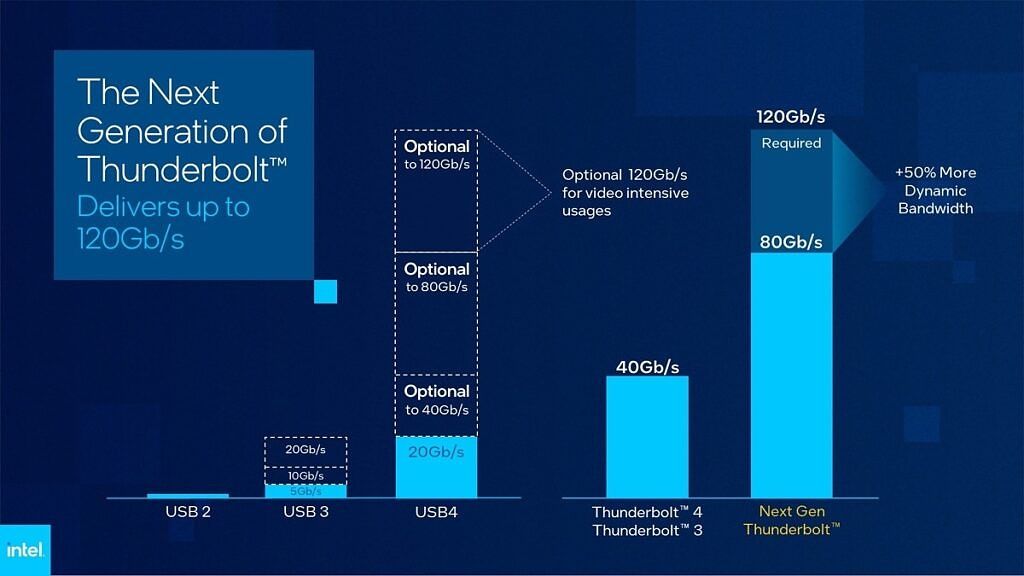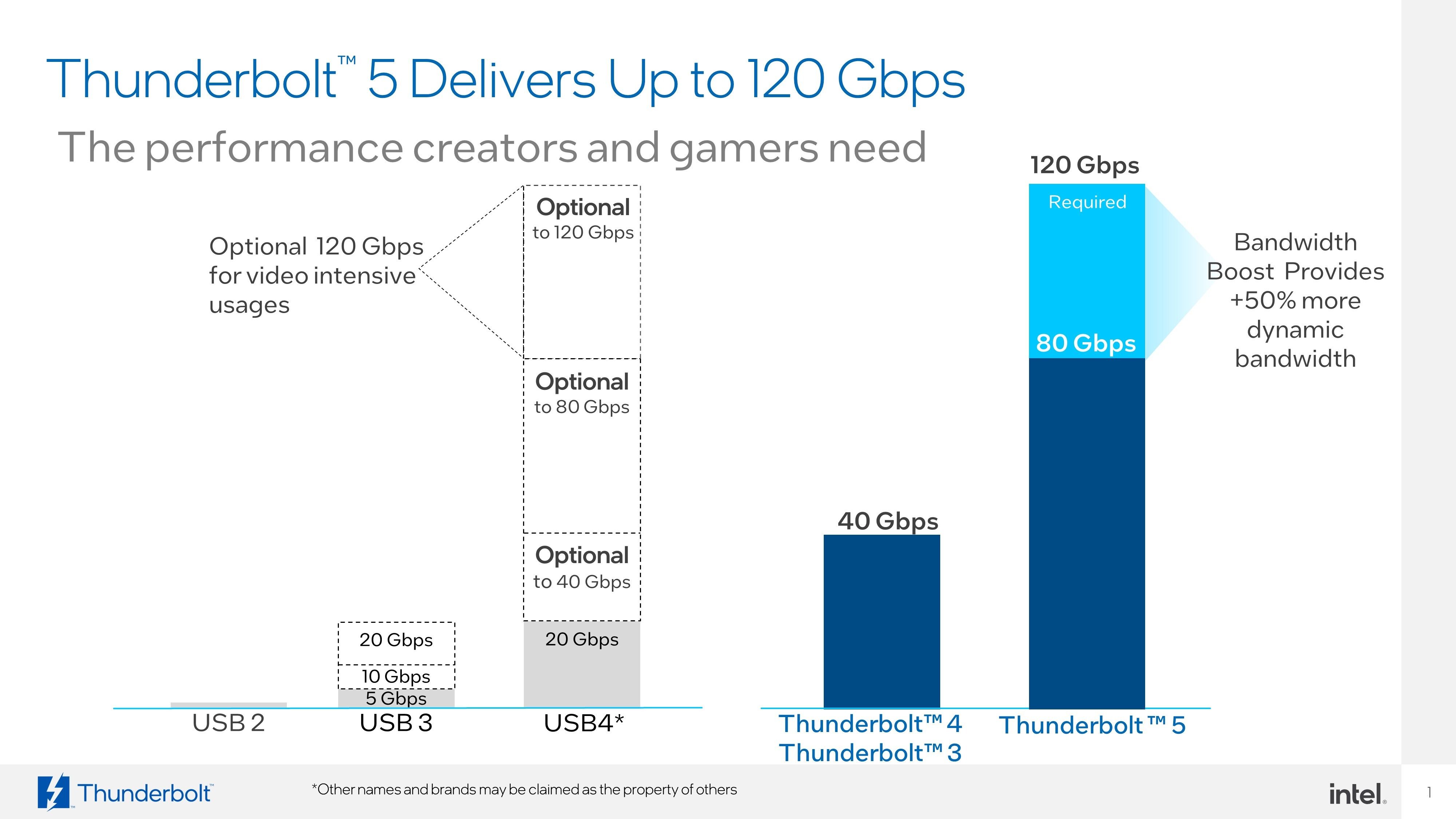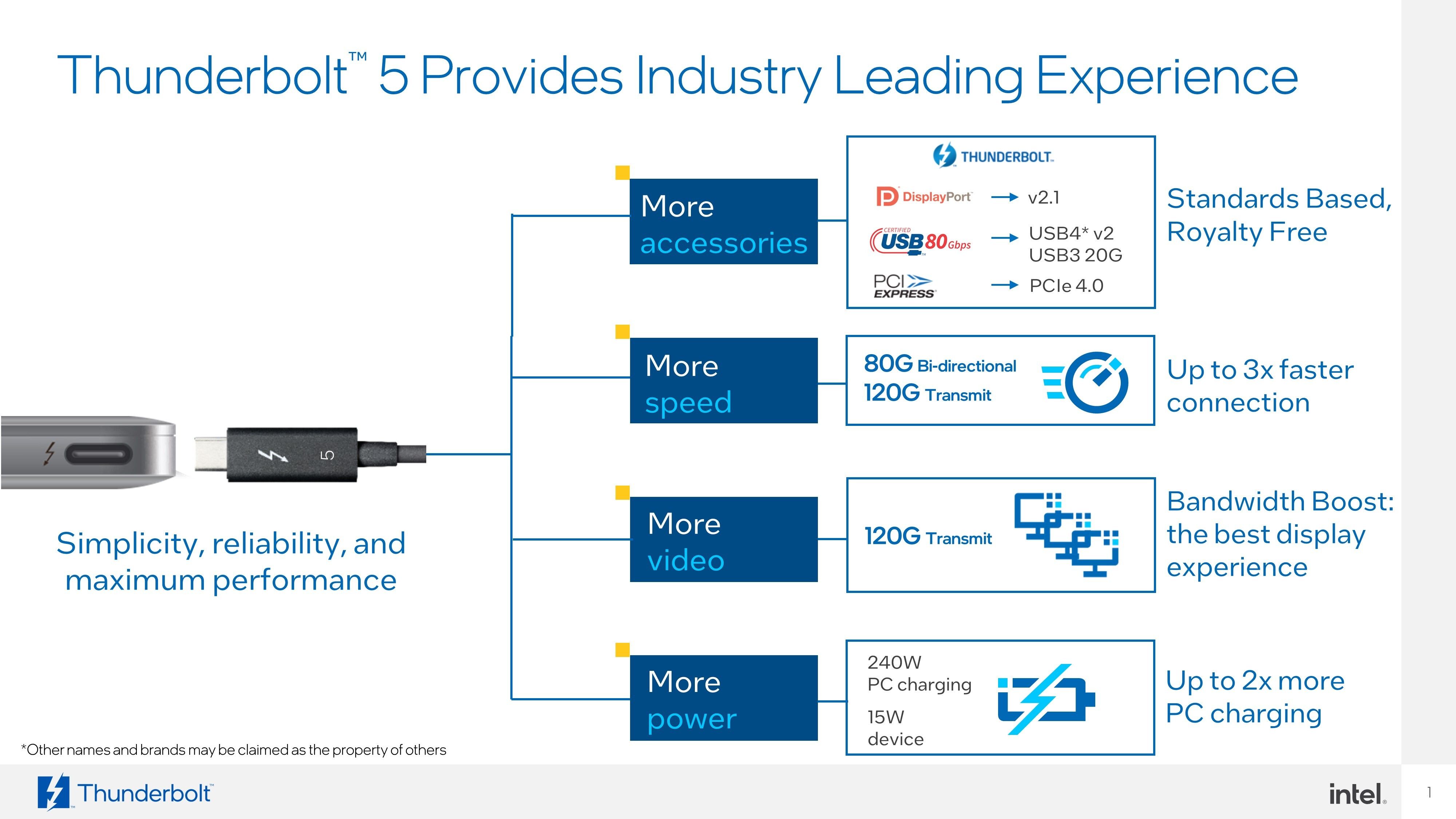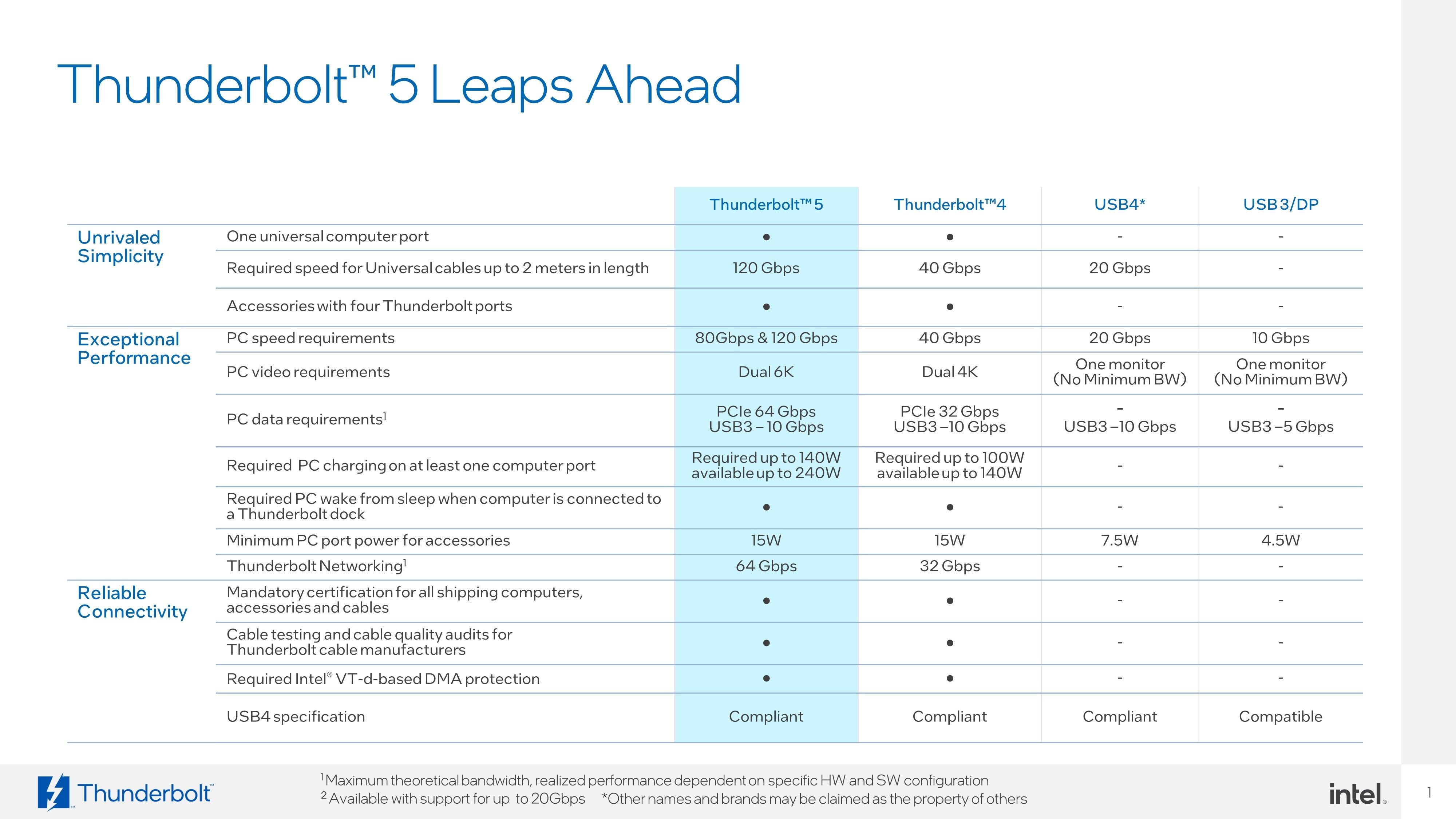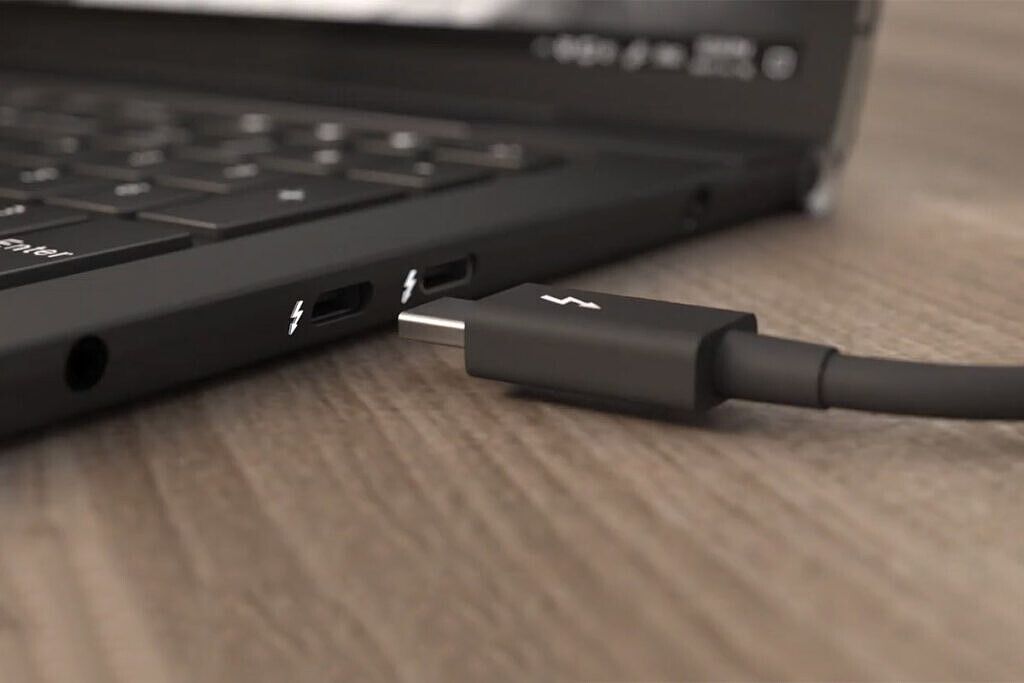Quick Links
Intel's Thunderbolt technology is a staple of high-end laptops and PCs, offering super-fast connectivity over a single USB Type-C port. While Thunderbolt ports look like any other USB-C port, they offer capabilities you won't find on most of them, with high bandwidth allowing for fast data, high-resolution displays, and even external graphics cards.
Thunderbolt 5 is the next generation of the technology, and it's promising to take things even further. Laptops with Thunderbolt 5 will launch in later in 2024, so here's everything you need to know about it.
What is Thunderbolt?
Thunderbolt is a hardware interface developed by Intel that was designed to allow users to connect peripherals to their PCs. Initial releases used the Mini DisplayPort connector, but Intel switched to USB Type-C starting with Thunderbolt 3. While it uses the same connector, Thunderbolt has usually offered much higher data rates than standard USB, making the technology very compelling. Thunderbolt connections enable things like plug-and-play external GPUs like the Razer Core X, in addition to external monitors and other peripherals thanks to Thunderbolt docks.
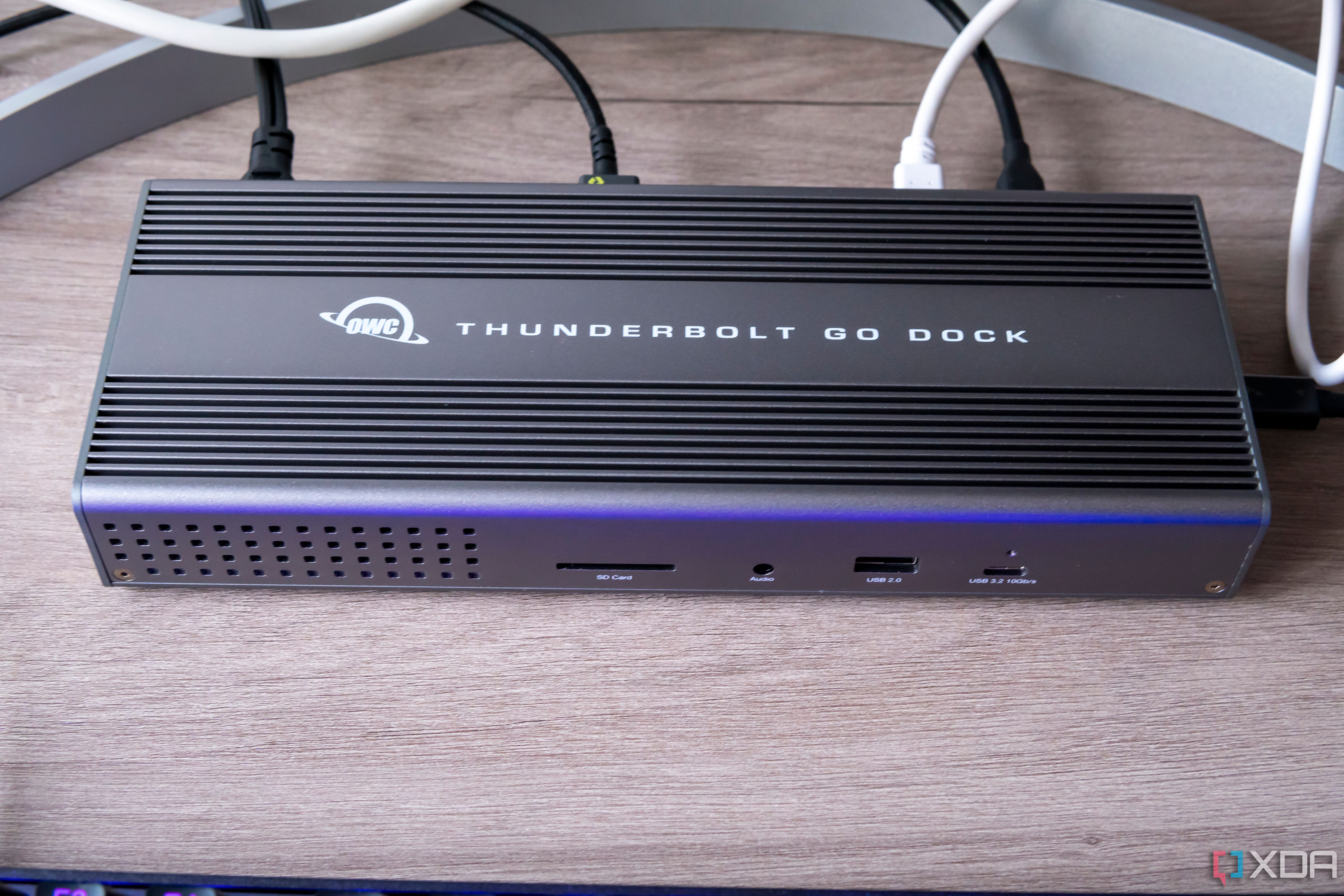
OWC Thunderbolt Go Dock review: Why aren't all docks like this?
The OWC Thunderbolt Go Dock is a very rare docking station with a built-in power supply, and that alone makes it one of the best I've ever tried.Of course, being developed by Intel, this technology is usually exclusive to Intel-based PCs. Thunderbolt 3 has been adopted by the USB Implementers Forum to be known as USB4, and there are a few non-Intel laptops that support it, like Lenovo's ThinkPad Z13 or Apple's MacBook Air. But Thunderbolt is still Intel technology, and while it is royalty-free, it has higher requirements. There are costs associated with certifying a device for Thunderbolt, so it's common for devices without Intel processors to forgo Thunderbolt certification and stick with regular USB ports. Even then, USB4 ports are only starting to become more common now.
What's unique about Thunderbolt, specifically starting with Thunderbolt 4, is that the certification requirements are pretty high. A laptop can have a USB4 port that only supports 20Gbps of bandwidth with no power delivery (PD) support, or it can go up to 40Gbps and add PD support. It's a flexible specification, but it can confuse consumers. On the other hand, a Thunderbolt 4 port has to support 40Gbps, power delivery, and PCIe tunneling for external GPUs. When you see a Thunderbolt 4 laptop, you have a much clearer idea of what you're getting.
What's new in Thunderbolt 5?
Thunderbolt 5 is a massive leap forward for the technology, delivering double the total bandwidth, but also improving how that bandwidth is handled in specific scenarios. Here are some of the big improvements:
80Gbps bi-directional bandwidth (or up to 120Gbps uni-directional)
The big upgrade with the next generation of Thunderbolt is going to be the maximum bandwidth, which is doubling from 40Gbps to 80Gbps bi-directional. In other words, Thunderbolt 5 will use four lanes of data, with each lane supporting 40Gbps. In a standard configuration, two lines go in each direction, giving you 80Gbps of bandwidth.
However, for special configurations, such as using very high-resolution displays, the lanes can dynamically be reconfigured so that three lanes are sending data in one direction. That means you get 120Gbps of bandwidth in one direction, with 40Gbps still available in the other direction. If you use very high-resolution monitors, this will make it possible to drive them using a single Thunderbolt port, even when you're using more than one.
This new bandwidth limit will be supported even on existing Thunderbolt 4 passive cables up to 1 meter in length, thanks to a new signaling technology. As long as your devices support Thunderbolt 5, the cable shouldn't be a concern.
All of these bandwidth improvements will also be available for devices using USB4 version 2.0, but again, the big thing to remember is that USB standards are flexible. While USB4 version 2.0 can have up to 80Gbps of bi-directional bandwidth, you might not always be able to tell which speeds are supported by a specific device. Thunderbolt 5 is going to have all of this as a baseline requirement.
New DisplayPort, PCI Express, and USB specifications
To go along with the new bandwidth limits, Thunderbolt 5 also supports the latest specifications for DisplayPort, PCIe, and USB data tunneling, just like USB4 version 2.0. For starters, that includes DisplayPort 2.1, which has specific improvements to how a DisplayPort signal is passed through a USB cable. This new version is more efficient, and it supports up to nearly 80Gbps of bandwidth for a DisplayPort signal, which can drive an 8K display at 60Hz with no stream compression or chroma subsampling. However, Thunderbolt 5 can also go beyond DisplayPort 2.1's capabilities, with support for up to three 4K 144Hz displays, and a minimum requirement to support dual 6K displays.
Thunderbolt 5 will also double the PCIe bandwidth, allowing even faster external storage or Thunderbolt networking, which are somewhat constrained by the current bandwidth limits. For reference, current Thunderbolt SSDs can hit speeds up to 2,800MB/s (advertised), so doubling that would result in a whopping 5,600MB/s, which is almost as fast as many internal SSDs are today. This also goes for things like external graphics cards, which can be even more powerful now.
Finally, the latest version of Thunderbolt will also support a new USB data tunneling protocol, USB 3.2 Gen 2x2, which delivers 20Gbps of bandwidth, but this isn't a requirement. Because USB 3.2 Gen 2x2 is extremely uncommon, the minimum target remains at USB 3.2 Gen 2, or 10Gbps of data.
More power
Finally, Thunderbolt 5 is also improving the power delivery capabilities of the technology. With Thunderbolt 4, a PC would have to support at least 100W charging through a Thunderbolt 4 port, and it could go up to 140W. Thunderbolt 5 takes this further by making 140W the minimum required power, meaning your laptop can charge even faster through a USB Type-C port.
What's more, the maximum supported power delivery is increasing, too. Laptops will be able to support up to 240W charging via Thunderbolt 5, making this a viable solution for many gaming laptops that still use proprietary charging connectors.
When is Thunderbolt 5 coming?
We don't have an exact date for Thunderbolt 5 to make its formal debut just yet, but we got to see some products featuring the technology at CES 2024. That includes the new Razer Blade 18, which is (so far) the only laptop known to include Thunderbolt 5 support. Razer has yet to announce a launch date for the Blade 18, though, and Intel also hasn't provided a more specific timeframe for Thunderbolt 5 to become publicly available.
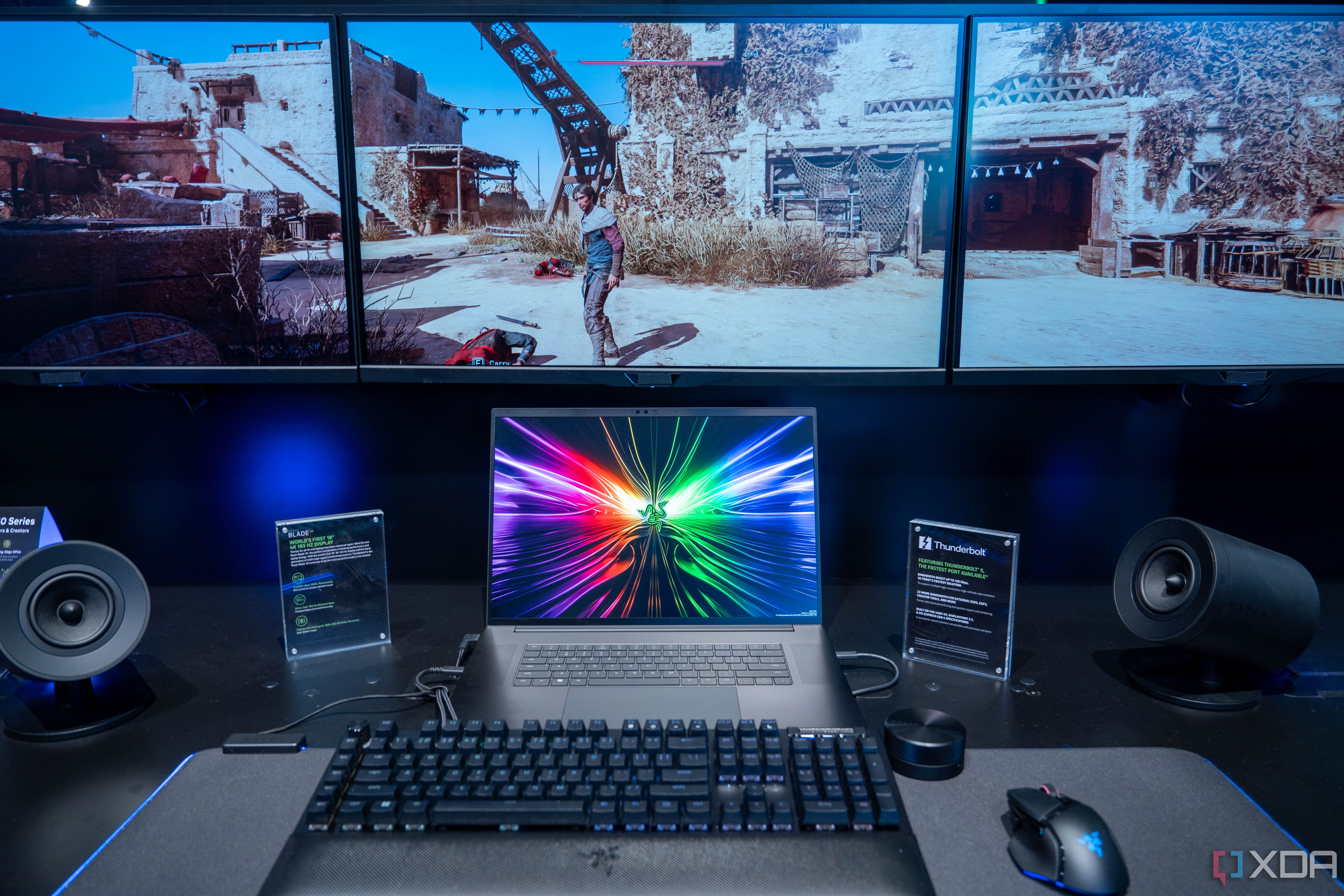
Behold, three 4K monitors connected to a laptop via a single cable
Thunderbolt 5 is coming soonOne thing worth noting is that you won't see Thunderbolt 5 on every laptop in the near future, even premium laptops with Intel processors. This is because Thunderbolt 5 isn't meant for everyone, and it's not a replacement for Thunderbolt 4, at least not yet. Intel is touting Thunderbolt 5 as a feature for enthusiasts and more demanding users, like creative professionals with high-bandwidth displays. Those are the devices where you'll see it first, and most ultrabooks and laptops will stick to Thunderbolt 4 for the time being.
Will my devices support it?
If you want to make full use of Thunderbolt 5, you're going to need devices that specifically support it, which don't yet exist. However, passive Thunderbolt 4 cables up to one meter in length can still support Thunderbolt 5, as we've mentioned above.
For laptops and computers, though, you'll have to specifically look for devices that support it, and it won't be all of them. With Thunderbolt 4, support for Thunderbolt was built into Intel's latest processors, so most ultrabooks and high-end laptops supported it. However, Thunderbolt 5 is meant for enthusiasts and more demanding users. Not every laptop will have this kind of capability, so you'll have to look closely at the specs to see what devices have it. Currently, only the Razer Blade 18 is known to include Thunderbolt 5 support, but there will surely be other high-performance laptops to include it.
Thunderbolt 5 ports will be backward compatible with existing Thunderbolt versions, though, so any accessories you have based on Thunderbolt 4 will still work. Of course, the bandwidth will be limited to whatever your older Thunderbolt device supports, so you can't get the benefits of Thunderbolt 5 magically on older devices. Thunderbolt should also work with devices regardless of the operating system — be it Windows 11, macOS, Chrome OS, or others.

